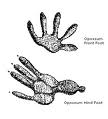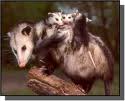|
|
 |
|
There are more
than 60 different species of opossum, which are often called possums. The most notable is the Virginia opossum or common opossum—the
only marsupial (pouched mammal) found in the United States and Canada. A female opossum gives birth to helpless
young as tiny as honeybees. Babies immediately crawl into the mother's pouch, where they continue to develop. As they get
larger, they will go in and out of the pouch and sometimes ride on the mother's back as she hunts for food. Opossums may give
birth to as many as 20 babies in a litter, but fewer than half of them survive. Some never even make it as far as the pouch.
|
 |
| Opossum Tracks |

|
Opossums are scavengers,
and they often visit human homes or settlements to raid garbage cans, dumpsters, and other containers. They are attracted
to carrion and can often be spotted near roadkill. Opossums also eat grass, nuts, and fruit. They will hunt mice, birds, insects,
worms, snakes, and even chickens.
These animals are most famous
for "playing possum." When threatened by dogs, foxes, or bobcats, opossums sometimes flop onto their sides and lie on the
ground with their eyes closed or staring fixedly into space. They extend their tongues and generally appear to be dead. This
ploy may put a predator off its guard and allow the opossum an opportunity to make its escape.
|
 |
|
|
|
 |
|
Opossum carry diseases such
as leptospirosis, tuberculosis, relapsing fever, tularemia, spotted fever, toxoplasmosis, coccidiosis, trichomoniasis, and
Chagas disease. They may also be infested with fleas, ticks, mites, and lice. Opossum are hosts for cat and dog fleas, especially
in urban environments.To deter opossums an array of chemical products is marketed for repelling various wildlife species but,
unfortunately, none offer significant results. The odor of mothballs or naphthalene crystals, used as a home remedy repellent,
has occasionally been reported to be successful in driving opossum from confined areas, but can build up toxicity in the soil.
There are no registered toxicants for poisoning opossum. Poison baits sold for the control of rodents should never be used
in an attempt to control opossum, skunks, or raccoons. The penalty for such pesticide misuse can be substantial and the practice
usually becomes known as a result of the accidental poisoning of someone's pet.

Opossums are excellent tree
climbers and spend much of their time aloft. They are aided in this by sharp claws, which dig into bark, and by a long prehensile
(gripping) tail that can be used as an extra limb. Opossums nest in tree holes or in dens made by other animals. These
animals are widespread and are sometimes hunted as food, particularly in the southern United States.
|
 |
|
|
|
|
|
|
|
 |

